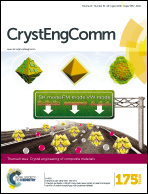Crystal engineering in 3D: converting nanoscale lamellar manganese oxide to cubic spinel while affixed to a carbon architecture†
Abstract
By applying differential pair distribution function (DPDF) analyses to the energy-storage relevant MnOx/carbon system—but in a 3D architectural rather than powder-composite configuration—we can remove contributions of the carbon nanofoam paper scaffold and quantify the multiphasic oxide speciation as the nanoscale, disordered MnOx grafted to the carbon walls (MnOx@CNF) structurally rearranges in situ from disordered birnessite AMnOx (A = Na+; Li+) to tetragonal Mn3O4 to spinel LiMn2O4. The first reaction step involves topotactic exchange of interlayer Na+ by Li+ in solution followed by thermal treatments to crystal engineer the ∼10 nm-thick 2D layered oxide throughout the macroscale nanofoam paper into a cubic phase. The oxide remains affixed to the walls of the nanofoam throughout the phase transformations. The DPDF fits are improved by retention of one plane of birnessite-like oxide after conversion to spinel. We support the DPDF-derived assignments by X-ray photoelectron spectroscopy and Raman spectroscopy, the latter of which tracks how crystal engineering the oxide affects the disorder of the carbon substrate. We further benchmark MnOx@CNF with nonaqueous electrochemical measurements versus lithium as the oxide converts from X-ray-amorphous birnessite to interlayer-registered LiMnOx to spinel. The lamellar AMnOx displays pseudocapacitive electrochemical behavior, with a doubling of specific capacitance for the interlayer-registered LiMnOx, while the spinel LiMn2O4@CNF displays a faradaic electrochemical response characteristic of Li-ion insertion. Our results highlight the need for holistic understanding when crystal engineering an (atomistic) charge-storing phase within the (architectural) structure of practical electrodes.

- This article is part of the themed collection: Crystal engineering of composite materials


 Please wait while we load your content...
Please wait while we load your content...